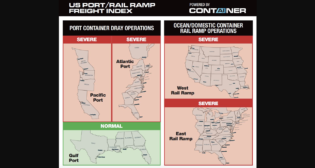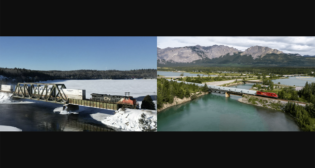
Sustainability: It’s not easy being green
Written by William C. Vantuono, Editor-in-Chief Following introductory remarks on pursuing a sustainability vision from GE Transportation Global Leader-Market Intelligence and Sustainability Initiatives Joe Williams (top) and Norfolk Southern Vice President and Chief Sustainability Officer Blair Wimbush (second from top), Environmental Defense Fund Senior Vice President Strategy and Communications Eric Pooley (third from top) addressed opportunities for the rail industry to reduce its carbon footprint. He also addressed the electric power generation industry’s gradual shift from burning coal to burning natural gas. This shift, largely driven by increasingly strict U.S. Environmental Protection Agency emissions regulations, has negatively impacted railroad coal traffic, a primary railroad revenue source.
Following introductory remarks on pursuing a sustainability vision from GE Transportation Global Leader-Market Intelligence and Sustainability Initiatives Joe Williams (top) and Norfolk Southern Vice President and Chief Sustainability Officer Blair Wimbush (second from top), Environmental Defense Fund Senior Vice President Strategy and Communications Eric Pooley (third from top) addressed opportunities for the rail industry to reduce its carbon footprint. He also addressed the electric power generation industry’s gradual shift from burning coal to burning natural gas. This shift, largely driven by increasingly strict U.S. Environmental Protection Agency emissions regulations, has negatively impacted railroad coal traffic, a primary railroad revenue source.
“Even though rail is six times more efficient than trucking, the rail industry has an annual carbon footprint of 35 million metric tons,” Pooley pointed out. “The railroads are making good progress on saving energy, but more needs to be done. It’s important that they share their best practices.”
“There are tremendous opportunities for railroads” Pooley said. For example, in a program he described as “synergy between competitors,”Ocean Spray decreased its carbon footprint, and cut its transportation costs by 40%, by shifting shipments from truck to rail. Ocean Spray is now using empty CSX Tropicana boxcars (the “Orange Juice Train”) in backhaul service to ship its products from New Jersey to Florida.
The shift from coal to natural gas is not a temporary phenomenon. Pooley said that, since 2008, the electric power generation industry has retired 14 GW (gigawatts) of energy derived from burning coal. By 2020, an additional 57 GW is scheduled to be retired. He cautioned, though, that natural gas leakage—from hydraulic fracturing, for example—may be more of a threat to the environment than emissions from burning coal. Consequently, “We need smart, flexible regulations,” he said.
Addressing the role of rail suppliers in sustainability, Stella Jones Corp. Vice President Marketing George Carlic (fourth from top) described how his company has implemented corporate safety practices and created an E&HS (Environmental Health and Safety) department. One key initiative is Stella-Jone’s SHIELD (Safety Health and Improved Environment Leading our Decisions) Program, which has been put in place throughout the company.
Stella-Jones is the largest supplier of treated wood products in North America, with 24 treating facilities, 15 in the U.S., and nine in Canada. “The sustainable wood crosstie is the crosstie of choice for 93% of all North American track applications,” Carlic noted. “Wood acts as a carbon sink, trapping greenhouse gases, and is the only renewable resource” among crosstie materials.
Crosstie treatment and disposal methods have come under environmental scrutiny in recent years. “The majority of wood crossties are treated with creosote, which is derived from the coking process of coal,” Carlic said. “Going forward, we need to develop an alternative to creosote.” One treatment method that has been successful is dual-treating crossties with borate and then creosote. Borate (which is relatively harmless to the environment) is injected first, and after achieving full penetration into the wood, a lesser amount of creosote is injected. This method, he said, uses six pounds of borate vs. eight pounds of creosote, per crosstie. “Reduced creosote retention is an opportunity to eliminate the use of creosote, and increases the potential for crossties as a recycled product.”
Creosote-only-treated crossties installed in the AWPA (American Wood Protection Association) Severe Rot Zone 4-5 were lasting an average of 12 years, Carlic explained. “In the late 1980s, Norfolk Southern installed borate pre-treated crossties in Cordele, Ga.,” he said. “Those ties have been in-track more than 25 years and have no signs of rot or insect attack degradation. All Class I railroads now using borate-treated wood ties.”
Crosstie disposal remains an issue, Carlic noted. With new crossties insertions expected to reach 23.7 million in 2015, about 20 million wood ties are coming out of track per year. Disposal methods have included reuse as relay or landscape ties, recycling ties to energy through co-generation, leaving them along right-of-way (a practice no longer allowed), or disposing of them in a landfill.
Burning old ties in a co-generation plant is becoming increasing difficult, due to new EPA regulations. “The EPA’s Boiler MACT (Maximum Achievable Control Technology) regulation, passed Jan. 31, 2013, is having an effect on co-generation,” Carlic said. “The law, which sets the existing source compliance date as Jan. 31, 2016, in effect designates used crossties as solid waste.” The Railway Tie Association, the Association of American Railroads, and others are working to reverse the law, he added.
“We must work together as an industry when issues arise that affect the sustainability of the products and services we provide,” Carlic concluded. “We achieved re-registration of preservatives. We need another tie disposal method. How do we work together to improve sustainability and cut costs? Sustainability is a powerful topic. In the railroad industry, it’s in its infancy.” Responding to a question from Railway Age about deriving cellulosic ethanol from used ties, Carlic pointed out that, after investigation, the process has been found to be “very expensive at present.”
CSX Assistant Vice President, Environmental Systems and Sustainability Carl Gerhardstein (bottom) talked about the railroad’s integration of CDP (Carbon Disclosure Project) reporting, and sustainability initiatives. (CDP is an international, not-for-profit, U.K.-based organization “providing the only global system for companies and cities to measure, disclose, manage, and share vital environmental information.”)
At CSX, Sustainability “is a business method that ensures safety, efficiency, and responsibility” throughout the railroad, in a manner that protects CSX employees, customers, and communities,” Gerhardstein observed. To minimize CSX’s environmental footprint, the railroad has established a goal of reducing hazardous waste generation at sites 25% by 2020.
One example is the “No Spike Left Behind” program, which started on the Jacksonville Division. Cleanup teams are now assigned to every CSX division to collect used spikes and other used steel items. These efforts not only eliminated waste, they produced $50 million in revenue from scrap steel last year.
CSX has enacted best practices in land remediation efforts, and improved its management practices across 400,000 acres of railroad-owned property on its rights-of-way. The railroad has also improved its water data and inventory collection methods, and reduced its water use by recycling and reusing water. In one project, 15 million gallons rainwater were collected and used for dust control.
CSX supports sustainable development through projects like its new intermodal terminals in Winter Haven, Fla. a CSX Select Site, that employs wide-span electric cranes to reduce onsite diesel emissions, solar energy panels and LED outdoor lighting that decreases power usage by 60%, and 100% recyclable steel ties that work well in within the terminal, but not on line-of-road.



